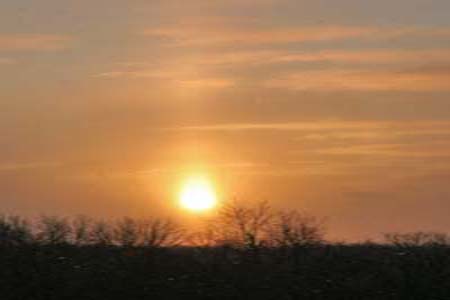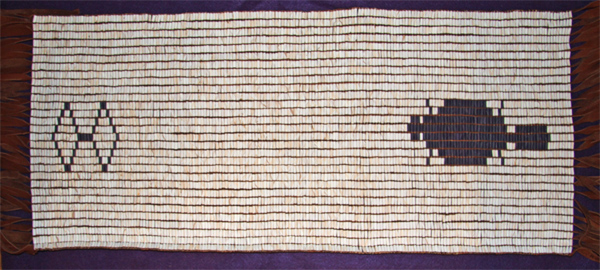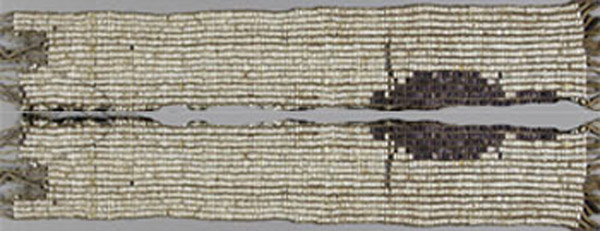 |
Photographs (left to right): December 25, 2009 Sunrise, Rush, New York; Pitcher Plant, Cranberry Glades, West Virginia; Cedar Key, Florida
Wampum Belt Archive
Beaver Belt
Only the top half exist today
Bottom image a mirror image to make the composite.
Cat #E91891 Smithsonian Institution, Department Anthropology.

Reconstruction of Beaver Belt R D Hamell 01/22/18
On the left edge of the original belt is a 4-bead purple diagonal. Mike Galban suggested is could be part of a diamond since the belt represents open trade. Because the agreement was between the Wyandotte and Haudenosaunee I added a second diamond with a connected pathway in order to have both nations represented. The warps on the original belt supports the report the belt was much longer and could have be 6-feet in length. It was my decision to end the belt 8 columns to the left of the diamonds.
Original Size: |
approx. Length 72.0 inches. Width estimate: 30 rows |
Reproduction: |
Beaded length: 35.8 inches. Width: 13.0 inches. Total length w/fringe: 60 inches |
Beads: |
Original partial belt about has approximately 164 columns. Based on the alleged size this belt may have had over 17,700 beads. Reproduction: 185 column long by 30 wide. Total: 5,550 beads. |
Materials: |
Warp: deer leather. Weft: artificial sinew. |
Description:
Text accompanying photograph: "This fragment is believed part of the six foot belt of white wampum with a beaver of purple or black woven into on end which was presented to Sastaretsi's Wyandots by the Seneca at Niagara. The beading was originally about 30 rows wide."
Wyandot Tradition states this was presented by the Seneca to the Wendat.
Fenton, Jennings and others suggest this could have been presented at a council in 1777 (Galban, 2013).
Stolle, Nickolaus (2016): Gift of Howard W. Elkinton in 1952, collected by Huldah H. Bonwill among the Wyandot in Oklahoma.
References:
Galban, Michael. 2013/2018. Personal Communications.
Stolle, Nickolaus. 2016. Talking Beads: The history of wampum as a value and knowledge bearer, from its very first beginnings until today. Hamburg, Germany. ISSN 1437-7837
 |
 |
 |
 |
 |
 |
 |
 |
|---|
